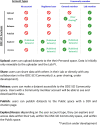Promoting FAIR Data Through Community-driven Agile Design: the Open Data Commons for Spinal Cord Injury (odc-sci.org)
- PMID: 34347243
- PMCID: PMC9537193
- DOI: 10.1007/s12021-021-09533-8
Promoting FAIR Data Through Community-driven Agile Design: the Open Data Commons for Spinal Cord Injury (odc-sci.org)
Abstract
The past decade has seen accelerating movement from data protectionism in publishing toward open data sharing to improve reproducibility and translation of biomedical research. Developing data sharing infrastructures to meet these new demands remains a challenge. One model for data sharing involves simply attaching data, irrespective of its type, to publisher websites or general use repositories. However, some argue this creates a 'data dump' that does not promote the goals of making data Findable, Accessible, Interoperable and Reusable (FAIR). Specialized data sharing communities offer an alternative model where data are curated by domain experts to make it both open and FAIR. We report on our experiences developing one such data-sharing ecosystem focusing on 'long-tail' preclinical data, the Open Data Commons for Spinal Cord Injury (odc-sci.org). ODC-SCI was developed with community-based agile design requirements directly pulled from a series of workshops with multiple stakeholders (researchers, consumers, non-profit funders, governmental agencies, journals, and industry members). ODC-SCI focuses on heterogeneous tabular data collected by preclinical researchers including bio-behaviour, histopathology findings and molecular endpoints. This has led to an example of a specialized neurocommons that is well-embraced by the community it aims to serve. In the present paper, we provide a review of the community-based design template and describe the adoption by the community including a high-level review of current data assets, publicly released datasets, and web analytics. Although odc-sci.org is in its late beta stage of development, it represents a successful example of a specialized data commons that may serve as a model for other fields.
Keywords: Data sharing; FAIR; community repository; data reuse; neurotrauma; spinal cord injury.
© 2021. The Author(s).
Conflict of interest statement
J.-B.P. was partially funded by National Institutes of Health (NIH) NIH-NIBIB P41 EB019936 (ReproNim) NIH-NIMH R01 MH083320 and NIH RF1 MH120021 (NIDM), NIMH Award Number R01MH096906 (Neurosynth), as well as the Canada First Research Excellence Fund, awarded to McGill University for the Healthy Brains for Healthy Lives initiative.
Figures







References
-
- Almeida, C. A., Torres-Espin, A., Huie, J. R., Sun, D., Noble-Haeusslein, L. J., Young, W., Beattie, M. S., Bresnahan, J. C., Nielson, J. L., Ferguson, A. R. (2021). Excavating FAIR Data: the Case of the Multicenter Animal Spinal Cord Injury Study (MASCIS), Blood Pressure, and Neuro-Recovery. Neuroinformatics. 10.1007/s12021-021-09512-z. - PMC - PubMed
-
- Basso DM, Beattie MS, Bresnahan JC, Anderson DK, Faden AI, Gruner JA, Holford TR, Hsu CY, Noble LJ, Nockels R, Perot PL, Salzman SK, Young W. MASCIS evaluation of open field locomotor scores: Effects of experience and teamwork on reliability. Multicenter Animal Spinal Cord Injury Study. Journal of Neurotrauma. 1996;13(7):343–359. doi: 10.1089/neu.1996.13.343. - DOI - PubMed
Publication types
MeSH terms
Grants and funding
LinkOut - more resources
Full Text Sources
Medical
Research Materials
Miscellaneous

